Abstract
The induced antibody response to the hapten p-azophenylarsonate in the A/J mouse has provided a model system for the detailed examination of a heritable crossreactive idiotype and its fine structural and serologic analysis. While earlier studies used to apparent homogeneity in the serum response for structural studies, a more complete understanding of the arsonate idiotypic system became possible with the development of monoclonal antibodies differing with respect to these determinants. Five monoclonal antibodies, four crossreactive idiotype positive and one crossreactive idiotype negative, were selected for complete amino acid sequence analysis. The sequences of the light chain variable regions of these molecules are presented here. The data indicate considerable sequence divergence of the monoclonal light chains from the serum light chains. However, there is a striking degree of homology among the monoclonal light chains regardless of the idiotype character of the parent molecule. Although minor variations are apparent throughout the variable regions, the joining regions are identical among light chains in all of these anti-arsonate antibodies. A particularly notable focus of variation is found at positions 92 and 93 in the third hypervariable region. The possible role of this region in the contribution of the light chain to the arsonate crossreactive idiotype is discussed. These data are consistent with the concept that the anti-arsonate monoclonal light chains originate from the joining of a specific J kappa gene segment to a single germ-line V kappa gene segment. These coding segments are likely further subject to a variety of somatic alterations that generate the modest sequence diversity found among the final protein products.
Full text
PDF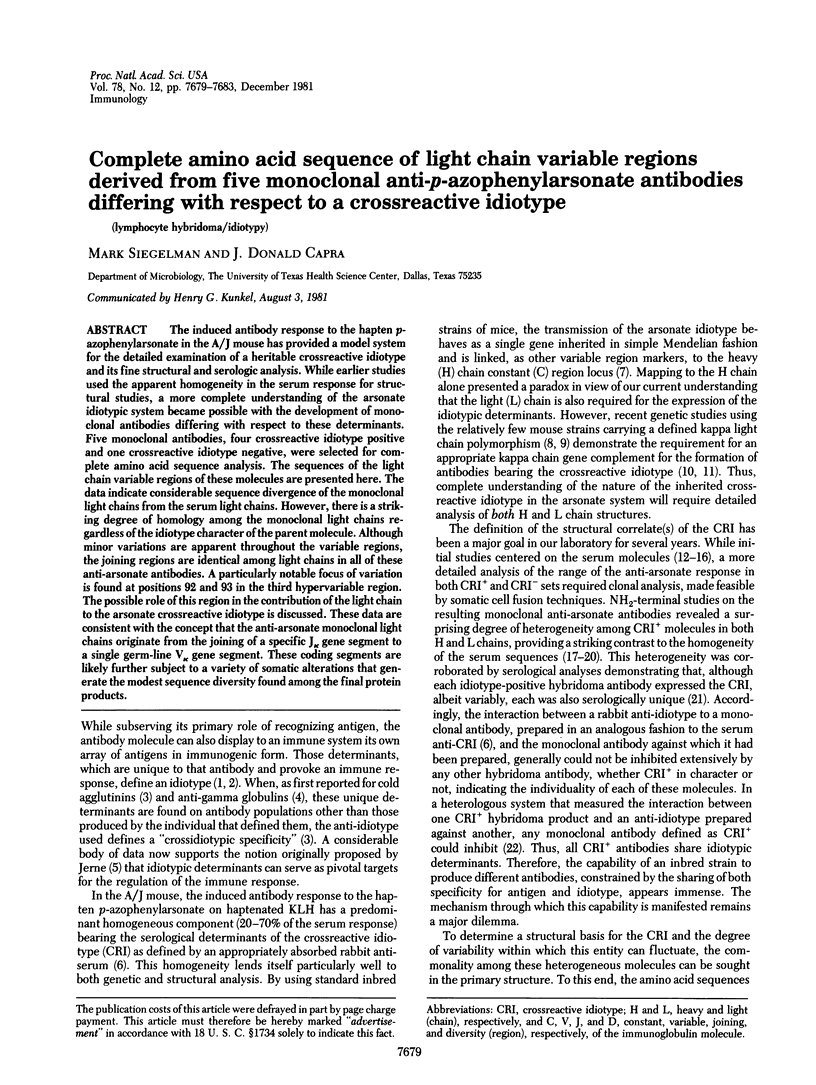
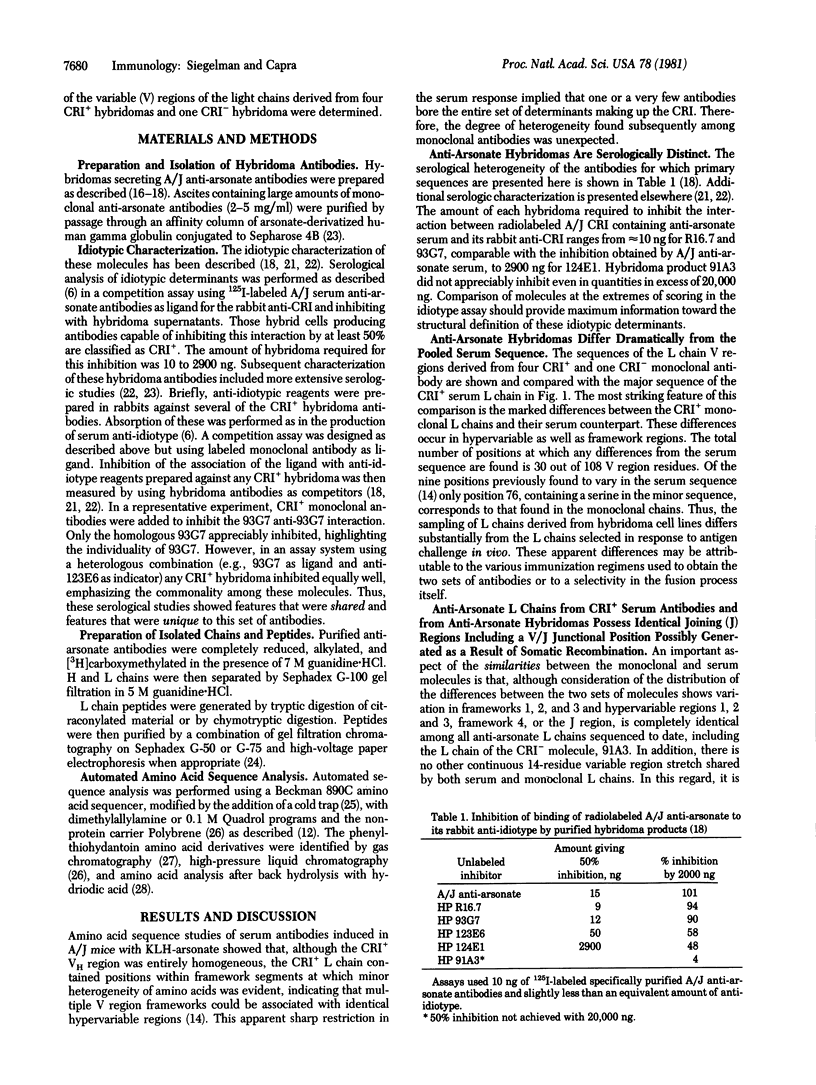
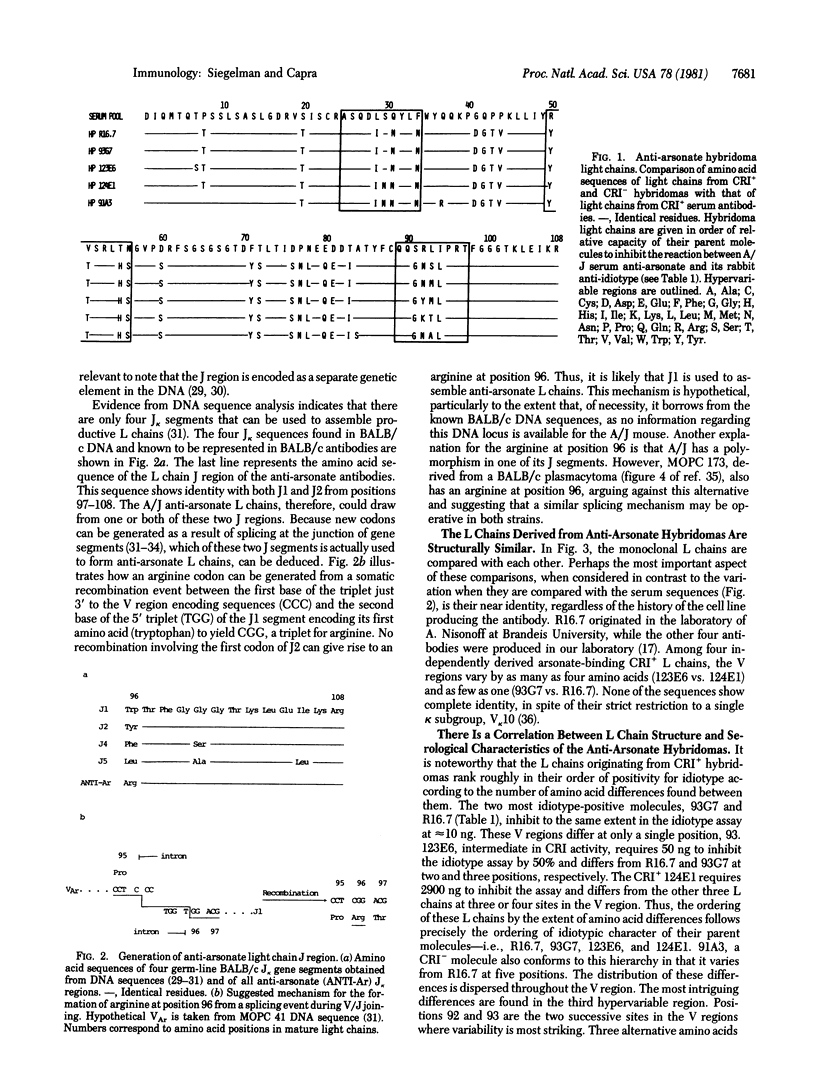
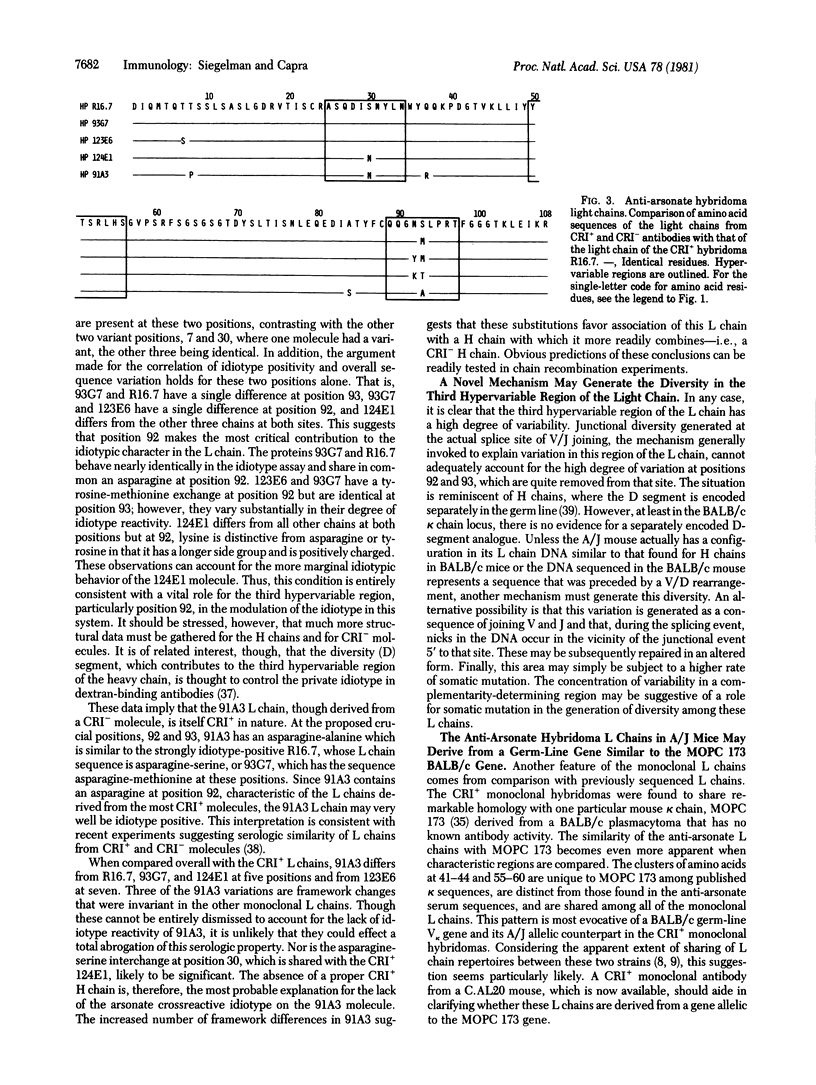
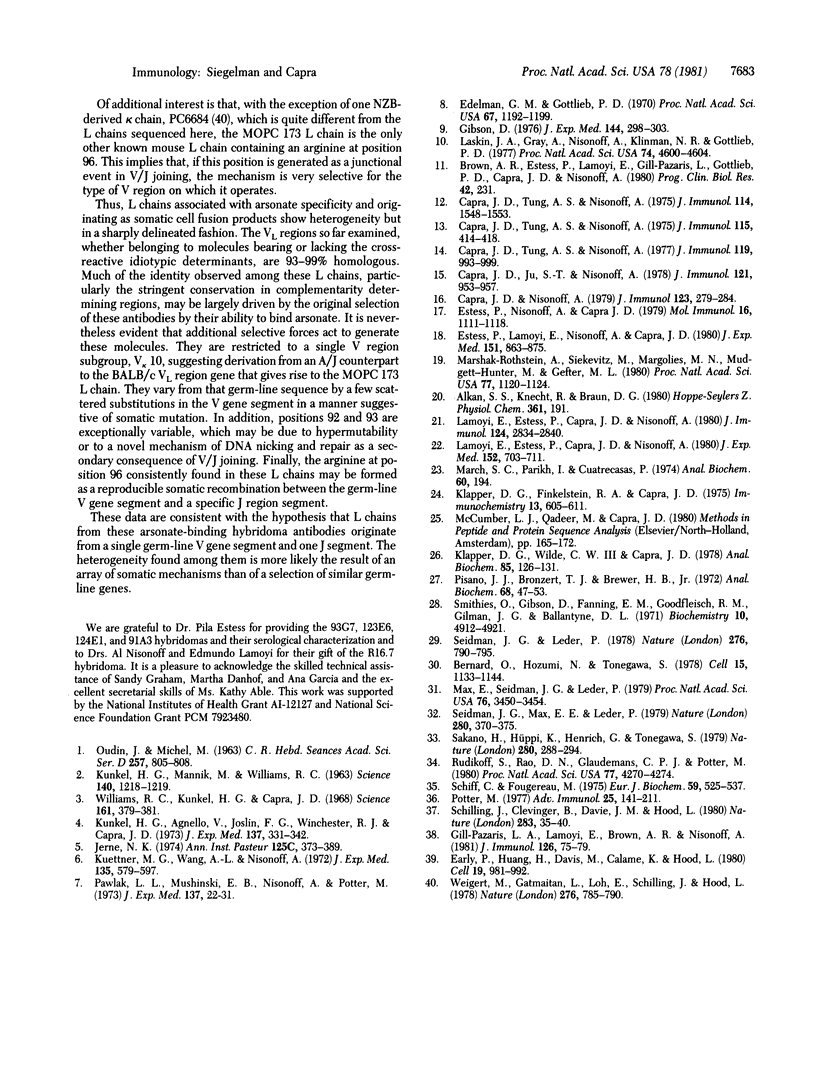
Selected References
These references are in PubMed. This may not be the complete list of references from this article.
- Alkan S. S., Knecht R., Braun D. G. The cross-reactive idiotype of anti-4-azobenzenearsonate hybridoma-derived antibodies in A/J mice constitutes multiple heavy chains. Hoppe Seylers Z Physiol Chem. 1980;361(2):191–195. [PubMed] [Google Scholar]
- Bernard O., Hozumi N., Tonegawa S. Sequences of mouse immunoglobulin light chain genes before and after somatic changes. Cell. 1978 Dec;15(4):1133–1144. doi: 10.1016/0092-8674(78)90041-7. [DOI] [PubMed] [Google Scholar]
- Brown A. R., Estess P., Lamoyi E., Gill-Pazaris L., Gottlieb P. D., Capra J. D., Nisonoff A. Studies of genetic control and microheterogeneity of an idiotype associated with anti-P-azophenylarsonate antibodies of A/J mice. Prog Clin Biol Res. 1980;42:231–247. [PubMed] [Google Scholar]
- Capra J. D., Ju S. T., Nisonoff A. Structural studies on induced antibodies with defined idiotypic specificities. VI. Amino terminal sequences of the heavy and light chain variable regions of anti-p-azophenylarsonate antibodies from A/J mice suppressed for a cross-reactive idiotype. J Immunol. 1978 Sep;121(3):953–957. [PubMed] [Google Scholar]
- Capra J. D., Nisonoff A. Structural studies on induced antibodies with defined idiotypic specificities. VII. The complete amino acid sequence of the heavy chain variable region of anti-p-azophenylarsenate antibodies from A/J mice bearing a cross-reactive idiotype. J Immunol. 1979 Jul;123(1):279–284. [PubMed] [Google Scholar]
- Capra J. D., Tung A. S., Nisonoff A. Structural studies on induced antibodies with defined idiotypic specificities. I. The heavy chains of anti-p-azophenylarsonate antibodies from A/J mice bearing a cross-reactive idiotype. J Immunol. 1975 May;114(5):1548–1553. [PubMed] [Google Scholar]
- Capra J. D., Tung A. S., Nisonoff A. Structural studies on induced antibodies with defined idiotypic specificities. II. The light chains of anti-p-azophenylarsonate antibodies from A/J mice bearing a cross-reactive idiotype. J Immunol. 1975 Aug;115(2):414–418. [PubMed] [Google Scholar]
- Capra J. D., Tung A. S., Nisonoff A. Structural studies on induced antibodies with defined idiotypic specificities. V. The complete amino acid sequence of the light chain variable regions of anti-p-azophenylarsonate antibodies from A/J mice bearing a cross-reactive idiotype. J Immunol. 1977 Sep;119(3):993–999. [PubMed] [Google Scholar]
- Early P., Huang H., Davis M., Calame K., Hood L. An immunoglobulin heavy chain variable region gene is generated from three segments of DNA: VH, D and JH. Cell. 1980 Apr;19(4):981–992. doi: 10.1016/0092-8674(80)90089-6. [DOI] [PubMed] [Google Scholar]
- Edelman G. M., Gottlieb P. D. A genetic marker in the variable region of light chains of mouse immunoglobulins. Proc Natl Acad Sci U S A. 1970 Nov;67(3):1192–1199. doi: 10.1073/pnas.67.3.1192. [DOI] [PMC free article] [PubMed] [Google Scholar]
- Estess P., Lamoyi E., Nisonoff A., Capra J. D. Structural studies on induced antibodies with defined idiotypic specificities. IX. Framework differences in the heavy- and light-chain-variable regions of monoclonal anti-p-azophenylarsonate antibodies from A/J mice differing with respect to a cross-reactive idiotype. J Exp Med. 1980 Apr 1;151(4):863–875. doi: 10.1084/jem.151.4.863. [DOI] [PMC free article] [PubMed] [Google Scholar]
- Estess P., Nisonoff A., Capra J. D. Structural studies on induced antibodies with defined idiotypic specificities--VIII. NH2-terminal amino acid sequence analysis of the heavy and light chain variable regions of monoclonal anti-para-azophenylarsonate antibodies from A/J mice differing with respect to a cross-reactive idiotype. Mol Immunol. 1979 Dec;16(12):1111–1118. doi: 10.1016/0161-5890(79)90045-2. [DOI] [PubMed] [Google Scholar]
- Gibson D. Genetic polymorphism of mouse immunoglobulin light chains revealed by isoelectric focusing. J Exp Med. 1976 Jul 1;144(1):298–303. doi: 10.1084/jem.144.1.298. [DOI] [PMC free article] [PubMed] [Google Scholar]
- Gill-Pazaris L. A., Lamoyi E., Brown A. R., Nisonoff A. Properties of a minor cross-reactive idiotype associated with anti-p-azophenylarsonate antibodies of A/J mice. J Immunol. 1981 Jan;126(1):75–79. [PubMed] [Google Scholar]
- Jerne N. K. Towards a network theory of the immune system. Ann Immunol (Paris) 1974 Jan;125C(1-2):373–389. [PubMed] [Google Scholar]
- Klapper D. G., Finkelstein R. A., Capra J. D. Subunit structure and N-terminal amino acid sequence of the three chains of cholera enterotoxin. Immunochemistry. 1976 Jul;13(7):605–611. doi: 10.1016/0019-2791(76)90173-7. [DOI] [PubMed] [Google Scholar]
- Klapper D. G., Wilde C. E., 3rd, Capra J. D. Automated amino acid sequence of small peptides utilizing Polybrene. Anal Biochem. 1978 Mar;85(1):126–131. doi: 10.1016/0003-2697(78)90282-8. [DOI] [PubMed] [Google Scholar]
- Kuettner M. G., Wang A. L., Nisonoff A. Quantitative investigations of idiotypic antibodies. VI. Idiotypic specificity as a potential genetic marker for the variable regions of mouse immunoglobulin polypeptide chains. J Exp Med. 1972 Mar 1;135(3):579–595. doi: 10.1084/jem.135.3.579. [DOI] [PMC free article] [PubMed] [Google Scholar]
- Kunkel H. G., Agnello V., Joslin F. G., Winchester R. J., Capra J. D. Cross-idiotypic specificity among monoclonal IgM proteins with anti- -globulin activity. J Exp Med. 1973 Feb 1;137(2):331–342. doi: 10.1084/jem.137.2.331. [DOI] [PMC free article] [PubMed] [Google Scholar]
- Kunkel H. G., Mannik M., Williams R. C. Individual Antigenic Specificity of Isolated Antibodies. Science. 1963 Jun 14;140(3572):1218–1219. doi: 10.1126/science.140.3572.1218. [DOI] [PubMed] [Google Scholar]
- Lamoyi E., Estess P., Capra J. D., Nisonoff A. Heterogeneity of an intrastrain cross-reactive idiotype associated with anti-p-azophenylarsonate antibodies of A/J mice. J Immunol. 1980 Jun;124(6):2834–2840. [PubMed] [Google Scholar]
- Lamoyi E., Estess P., Capra J. D., Nisonoff A. Presence of highly conserved idiotypic determinants in a family of antibodies that constitute an intrastrain cross-reactive idiotype. J Exp Med. 1980 Sep 1;152(3):703–711. doi: 10.1084/jem.152.3.703. [DOI] [PMC free article] [PubMed] [Google Scholar]
- Laskin J. A., Gray A., Nisonoff A., Klinman N. R., Gottlieb P. D. Segregation at a locus determining an immunoglobulin genetic marker for the light chain variable region affects inheritance of expression of an idiotype. Proc Natl Acad Sci U S A. 1977 Oct;74(10):4600–4604. doi: 10.1073/pnas.74.10.4600. [DOI] [PMC free article] [PubMed] [Google Scholar]
- Marshak-Rothstein A., Siekevitz M., Margolies M. N., Mudgett-Hunter M., Gefter M. L. Hybridoma proteins expressing the predominant idiotype of the antiazophenylarsonate response of A/J mice. Proc Natl Acad Sci U S A. 1980 Feb;77(2):1120–1124. doi: 10.1073/pnas.77.2.1120. [DOI] [PMC free article] [PubMed] [Google Scholar]
- Max E. E., Seidman J. G., Leder P. Sequences of five potential recombination sites encoded close to an immunoglobulin kappa constant region gene. Proc Natl Acad Sci U S A. 1979 Jul;76(7):3450–3454. doi: 10.1073/pnas.76.7.3450. [DOI] [PMC free article] [PubMed] [Google Scholar]
- OUDIN J., MICHEL M. [A new allotype form of rabbit serum gamma-globulins, apparently associated with antibody function and specificity]. C R Hebd Seances Acad Sci. 1963 Jul 17;257:805–808. [PubMed] [Google Scholar]
- Pawlak L. L., Mushinski E. B., Nisonoff A., Potter M. Evidence for the linkage of the IGC H locus to a gene controlling the idiotypic specificity of anti-p-azophenylarsonate antibodies in strain A mice. J Exp Med. 1973 Jan 1;137(1):22–31. doi: 10.1084/jem.137.1.22. [DOI] [PMC free article] [PubMed] [Google Scholar]
- Potter M. Antigen-binding myeloma proteins of mice. Adv Immunol. 1977;25:141–211. [PubMed] [Google Scholar]
- Rudikoff S., Rao D. N., Glaudemans C. P., Potter M. kappa Chain joining segments and structural diversity of antibody combining sites. Proc Natl Acad Sci U S A. 1980 Jul;77(7):4270–4274. doi: 10.1073/pnas.77.7.4270. [DOI] [PMC free article] [PubMed] [Google Scholar]
- Sakano H., Hüppi K., Heinrich G., Tonegawa S. Sequences at the somatic recombination sites of immunoglobulin light-chain genes. Nature. 1979 Jul 26;280(5720):288–294. doi: 10.1038/280288a0. [DOI] [PubMed] [Google Scholar]
- Schiff C., Fougereau M. Determination of the primary structure of a mouse IgG2a immunoglobulin. Amino-acid sequence of the light chain. Eur J Biochem. 1975 Nov 15;59(2):525–537. doi: 10.1111/j.1432-1033.1975.tb02479.x. [DOI] [PubMed] [Google Scholar]
- Schilling J., Clevinger B., Davie J. M., Hood L. Amino acid sequence of homogeneous antibodies to dextran and DNA rearrangements in heavy chain V-region gene segments. Nature. 1980 Jan 3;283(5742):35–40. doi: 10.1038/283035a0. [DOI] [PubMed] [Google Scholar]
- Seidman J. G., Leder P. The arrangement and rearrangement of antibody genes. Nature. 1978 Dec 21;276(5690):790–795. doi: 10.1038/276790a0. [DOI] [PubMed] [Google Scholar]
- Seidman J. G., Max E. E., Leder P. A kappa-immunoglobulin gene is formed by site-specific recombination without further somatic mutation. Nature. 1979 Aug 2;280(5721):370–375. doi: 10.1038/280370a0. [DOI] [PubMed] [Google Scholar]
- Smithies O., Gibson D., Fanning E. M., Goodfliesh R. M., Gilman J. G., Ballantyne D. L. Quantitative procedures for use with the Edman-Begg sequenator. Partial sequences of two unusual immunoglobulin light chains, Rzf and Sac. Biochemistry. 1971 Dec 21;10(26):4912–4921. doi: 10.1021/bi00802a013. [DOI] [PubMed] [Google Scholar]
- Weigert M., Gatmaitan L., Loh E., Schilling J., Hood L. Rearrangement of genetic information may produce immunoglobulin diversity. Nature. 1978 Dec 21;276(5690):785–790. doi: 10.1038/276785a0. [DOI] [PubMed] [Google Scholar]
- Willims R. C., Jr, Kunkel H. G., Capra J. D. Antigenic specificities related to the cold agglutinin activity of gamma M globulins. Science. 1968 Jul 26;161(3839):379–381. doi: 10.1126/science.161.3839.379. [DOI] [PubMed] [Google Scholar]


